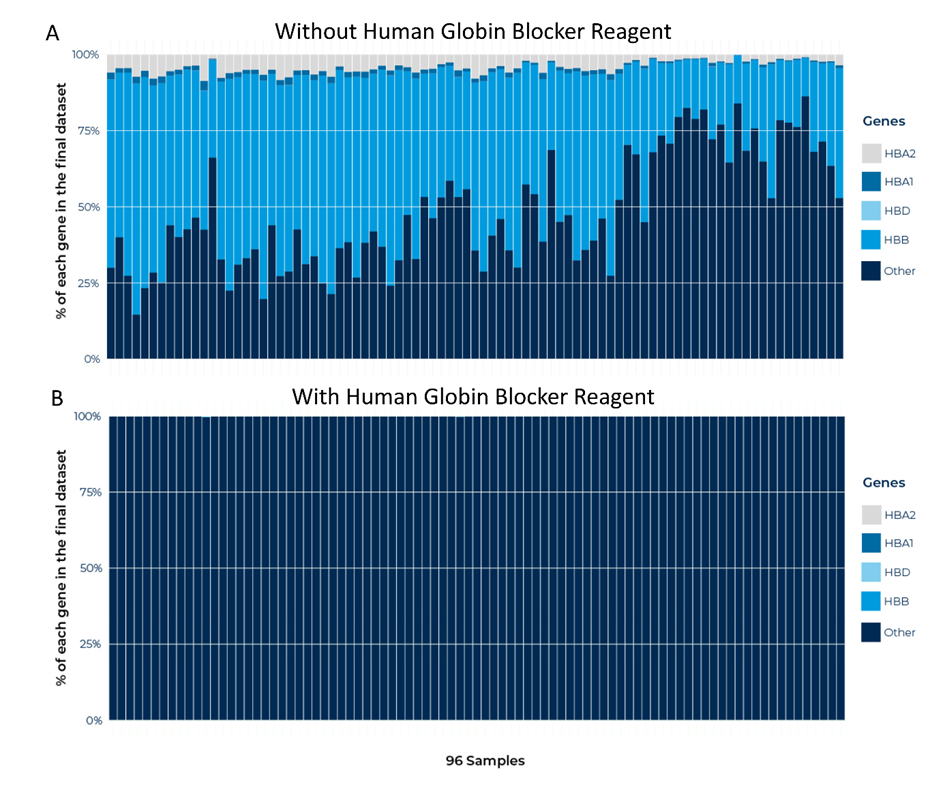Ultra-high-throughput whole blood Bulk RNA Barcoding and Sequencing from Alithea Genomics (MERCURIUS™ Blood BRB-seq) provides researchers and companies with numerous benefits compared to traditional blood RNA-seq approaches.
The technology seamlessly integrates reagents that reduce the amount of globin mRNA in whole blood samples before sequencing to reduce noise from these highly expressed transcripts. The technology allows researchers to sequence hundreds of whole blood transcriptomes simultaneously at higher sensitivities and at much lower costs than ever before.
In this article, we discuss the benefits of MERCURIUS™ Blood BRB-seq such as the inclusion of human globin blocker reagents and the increased sensitivity to detect the majority of expressed genes in whole blood.
Benefits of human globin blocker
One of the main benefits of MERCURIUS™ Blood BRB-seq is the seamless integration of human globin blockers.
Extremely high levels of globin mRNAs from immature erythrocytes are present in isolated whole blood RNA (Mastrokolias et al., 2012; Mele et al., 2015). It is important to remove these globin transcripts before sequencing. Their removal increases the amount of reads available to detect interesting gene candidates from the rest of the blood transcriptome.
To determine the effectiveness of the human globin blocker reagent in removing globin transcripts, we sequenced 96 whole blood samples with MERCURIUS™ Blood BRB-seq with and without pre-treatment with the human globin blocker reagent (Fig. 1).

Figure 1. Pre-treatment of whole blood RNA with human globin blocker removes globin mRNAs in MERCURIUS™ BRB-seq results. (A) Stacked bar chart showing the percentage of each globin gene transcript and non-globin transcripts (dark blue; other) in the final dataset for 96 whole blood samples not treated with globin blocker reagent sequenced with MERCURIUS™ BRB-seq (B) Stacked bar chart showing the percentage of transcripts for the same 96 samples but treated with globin blocker reagent.
In the 96 samples not treated with human globin blocker, the majority of mapped reads were associated with globin genes (Fig. 1A). For example, the most common form of globin in adults hemoglobin subunit beta (HBB) represented up to 70% of all sequenced transcripts in the final dataset depending on the sample (Fig. 1A). Hemoglobin Subunit Alpha 2 (HBA2) also represented a substantial fraction of sequencing reads (Fig. 1A).
Strikingly, the percentage of other non-globin transcripts was as little as 20% in some samples (Fig. 1A).
In contrast, when the same samples were treated with globin blocker reagent, almost all globin mRNA transcripts were removed and nearly 100% of transcripts sequenced were from genes other than globin genes (Fig. 1b).
Therefore, treatment of samples with the human globin blocker reagent in MERCURIUS™ Blood BRB-seq gives researchers maximum sensitivity to detect relevant and interesting gene candidates by reducing excessive globin mRNAs.
Robust detection of gene expression
Another key benefit of MERCURIUS™ Blood BRB-seq is that it can consistently detect the expression of over 15,000 genes in whole blood. Even genes with low expression levels were robustly detected by MERCURIUS™ Blood BRB-seq after treatment with human globin blocker reagent (Fig. 2).
This shows that this ultra-high-throughput sequencing technology provides accurate and sensitive data across most expressed genes in human whole blood.

Figure 2. MERCURIUS™ Blood BRB-seq consistently detects the expression of over 15,000 genes in 96 whole blood samples, even with low counts per million (CPM) expression levels. Stacked bar chart showing the number of genes detected for 96 whole blood samples sequenced by MERCURIUS™ Blood BRB-seq. Gene expression level is indicated by count per million (CPM). The library was sequenced at an average of 1 million reads per sample on an Illumina NextSeq 550.
Cost benefit of MERCURIUS™ Blood BRB-seq
Another benefit to researchers and companies is the very low cost per sample of MERCURIUS™ Blood BRB-seq (Alpern et al., 2019). From as little as 7 euros per sample for library preparation, researchers can now afford to generate genome-wide transcriptomic data for whole blood samples on an unprecedented scale. This is critical for large-scale studies that require many samples or replicates.
Alithea Genomics also provides an integrated RNA extraction service from PAXgene® blood RNA tubes (PreAnalytiX), Tempus™ blood RNA tubes (Applied Biosystems), and RNA shield blood tubes (Zymo Research). This allows researchers to streamline the complete blood transcriptomic pipeline, from RNA extraction, to sequencing and data analysis.
The numerous benefits of MERCURIUS™ Blood BRB-seq will undoubtedly help to revolutionize large-scale, blood-based investigative studies to improve human health of the future.
To find out more about how MERCURIUS™ Blood BRB-seq can help in your study, please contact us at info@alitheagenomics.com.
References
- Alpern, D., Gardeux, V., Russeil, J., Mangeat, B., Meireles-Filho, A.C., Breysse, R., Hacker, D. and Deplancke, B., 2019. BRB-seq: ultra-affordable high-throughput transcriptomics enabled by bulk RNA barcoding and sequencing. Genome biology, 20(1), pp.1-15.
- Mastrokolias, A., den Dunnen, J.T., van Ommen, G.B., t Hoen, P.A. and van Roon-Mom, W., 2012. Increased sensitivity of next generation sequencing-based expression profiling after globin reduction in human blood RNA. Bmc Genomics, 13(1), pp.1-9.
- Melé, M., Ferreira, P.G., Reverter, F., DeLuca, D.S., Monlong, J., Sammeth, M., Young, T.R., Goldmann, J.M., Pervouchine, D.D., Sullivan, T.J. and Johnson, R., 2015. The human transcriptome across tissues and individuals. Science, 348(6235), pp.660-665.


